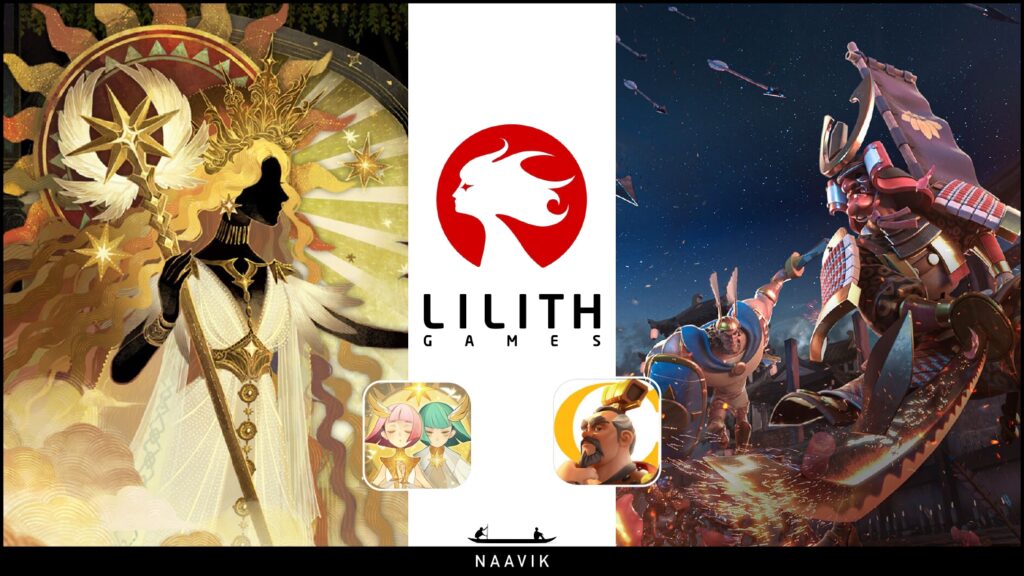Hi Everyone. Welcome to another issue of Naavik Digest! If you missed last issue, be sure to check out our dive into in-car entertainment and what it means for developers. This week, we look at the state of the virtual and augmented reality market — how it’s shaking out as the metaverse hype subsides a bit, and what to expect from Apple and Sony.
Build or Buy: Gaming Backends

Choosing a backend is one of the most important choices a developer can make in their product lifecycle and has long lasting implications on live service matchmaking, commerce, security, and account structure. Should you build or buy? What are the pros and cons, and what comes off the shelf vs. custom use?
In today’s episode your host, Alexandra Takei, talks with Eden Chen, the founder and CEO of Pragma, a gaming backend service trying to level up backends to be built alongside a modern 2020s gaming studio. How is Pragma different than incumbents? Tune in to find out
You can find us on YouTube, Spotify, Apple Podcasts, Google Podcasts, YouTube, our website, or anywhere else you listen to podcasts. Also, remember to shoot us any questions here.
#1: The State of the VR in 2023

It’s been more than a decade since the rise of modern virtual reality, and yet the market remains relatively small when compared to other gaming platforms and consumer electronics categories. According to NewZoo, the VR install base is expected to reach 46 million by 2024. The number is indeed far below that of mobile and PC & console markets — according to NewZoo, there were 3.2 billion gamers in 2022. However, if we focus solely on the VR market, we can see stable and continuous growth over the last several years.
There are a few key reasons for the surge in recent growth, including the emergence of affordable wireless headsets starting with the original Oculus Quest in 2019 and the resilience of premium, corded headsets like the Valve Index and the HP Reverb G2. But more importantly, since 2020 the VR market has experienced a boost as a result of the COVID-19 pandemic, as part of the broader increase in consumer spending and engagement on gaming during the era of pandemic lockdowns.
Additionally, the pandemic spurred new use cases for VR, including remote meetings, education, and virtual live entertainment such as concerts and events. These developments dovetailed with the metaverse boom, led by the rise of web3 and an increased interest in VR technologies as one of many crucial components of an eventual next-generation internet (the importance of VR to the metaverse is of course integral to how Meta CEO Mark Zuckerberg envisions the technology and why, in the fall of 2021, he felt compelled to rebrand Facebook accordingly).
However, in 2023 the landscape has changed yet again. Web3 is struggling to retain the interest it enjoyed in 2021 following the onset of last year’s crypto winter. While VR is still enjoying increased interest compared to pre-pandemic levels, market research firm IDC this month adjusted its forecast for 2023 and now estimates slower growth this year for VR/AR device shipments (but growth nonetheless).
“Among the various form factors, standalone VR headsets will face challenges in 2023 due their extreme popularity in 2020 and 2021 leading to unfavorable year-over-year comparisons and the dependence on Meta's product launch schedule,” IDC wrote. “However, tethered VR as well as tethered AR glasses headsets will face a relatively easier path to growth due to the dearth of volumes in 2022.” IDC says it still expects VR shipments to grow 14% this year and enjoy a five-year compound annual growth rate of 32.6%.
Now, with most of the pandemic-era buzz behind us, we have a good opportunity to take stock of the VR market, where it stands today, and where we believe it’s headed in the future. We will also touch on the state of the mobile AR market, since AR is so closely associated with VR, though advancements in hardware remain much farther out.
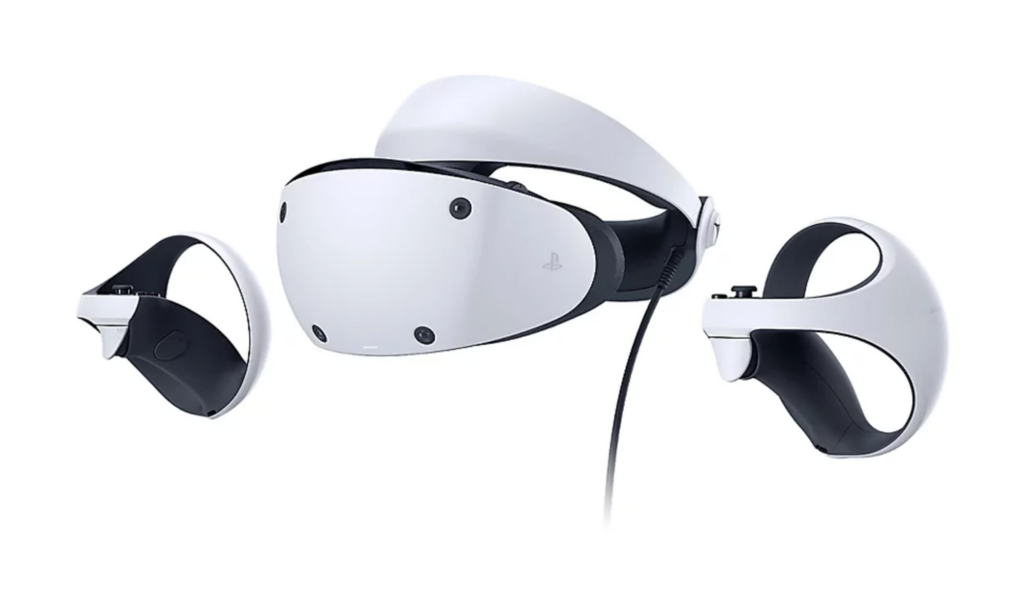
Where VR Stands in 2023
In 2023, VR has yet to become a staple device for the average gamer in the gaming industry. Despite numerous AAA game releases, integration with gaming metaverses, and ongoing R&D support from tech giants like Meta, Sony, and Apple, VR remains primarily an optional peripheral for the general consumer.
However, in recent years, VR has seen significant advancements in both hardware sophistication and the quality of software releases. An increasing number of AAA game developers are beginning to create VR adaptations of their games. And yet, for VR to truly become the next big thing, the current progress remains insufficient. We’ll specifically focus on the present state of the market and its potential for growth.
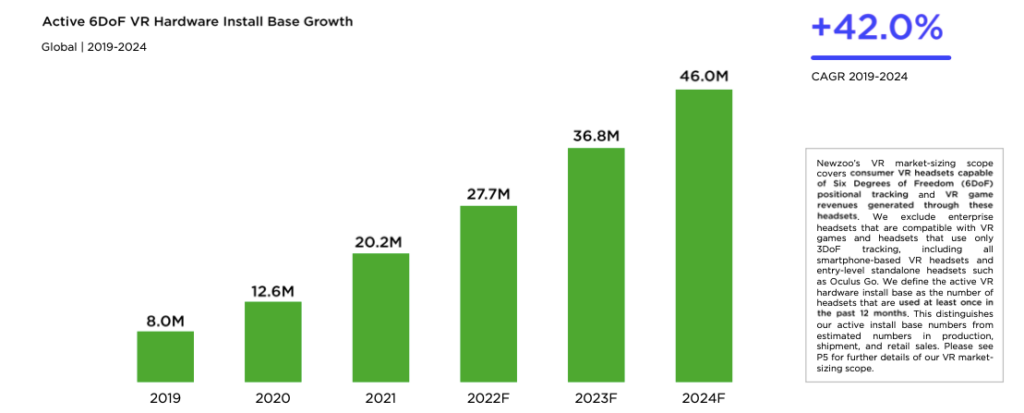
A primary factor contributing to the growth of the VR market is the growing awareness of consumers regarding VR/AR technology and its potential. Furthermore, progress in both hardware and software is making VR/AR technology increasingly accessible and cost-effective, which should also help fuel market expansion. Meta’s standalone VR headsets, originally under the Oculus brand and now the Meta Quest line, have played a significant role in making VR/AR technology more accessible to mainstream audiences. Meta’s headsets have over 84% market share of the VR hardware market, according to IDC.
Despite the potential for increased competition from Sony due to the recent launch of the PS VR2, the current situation tells a different tale. The PS VR2 launch has been less than stellar. Pre-orders for PS VR2 began in November of the previous year, and stores have continued accepting them before the official launch without waitlists. As reported by Bloomberg in January, Sony allegedly lowered its projections following underwhelming pre-order results.
However, Sony remains confident in its product and envisions the VR market as a significant area for growth, with the potential for record-breaking sales on the PS VR2. Increased competition may help spur more investment in the sector, though it’s not clear Sony will achieve a greater level of success than it did with its first VR headset.
Although there have been considerable improvements in both hardware and software, VR/AR gaming still faces challenges that must be addressed before these technologies can fully enter the mainstream. One major obstacle is the cost of entry, as high-end VR headsets can be quite pricey and necessitate powerful hardware to operate. Another is the general consumer’s comfort level using VR for more than just short bursts of time.
To accommodate market demands, Meta had to reduce the price for its Quest Pro VR headset; now, the Meta Quest Pro is priced at $999.99, down from the initial $1,499.99. Meanwhile, Apple employees have reportedly expressed concerns internally over the company's forthcoming $3,000 AR glasses, The New York Times reported, as the high price point may be prohibitive and particularly so in a niche and nascent market. The headset is also said to require an external battery, and some testers of the device have described extended use of it as “uncomfortable,” according to Bloomberg.
Moreover, the present selection of VR/AR games is somewhat restricted, despite the success of certain titles. Some of these titles, such as Half-Life: Alyx (2020), Beat Saber (2019), or Superhot VR (2016), might serve as system-sellers for many gamers. Furthermore, successful PC and console games have created popular VR adaptations, like The Elder Scrolls V: Skyrim VR (2017) and Resident Evil 7 (2017).
Additionally, more franchises are venturing into the VR realm, including Sony’s Horizon franchise with the launch of Horizon Call of the Mountain and Supermassive’s The Dark Pictures Anthology with the release of The Dark Pictures: Switchback VR.
The Ever Challenging State of Mobile AR
In the realm of smartphone-based AR gaming, which remains one of the only viable use cases for AR at the moment, the challenges appear even more pronounced. By examining data.ai's Top 10 mobile location-based games with AR features by in-app purchase (IAP) revenue, we can gain insight into the market composition. Pokémon Go dominates the market, earning more annually than all other games combined. The second-highest grossing title, Dragon Quest Walk, generates three times less than Pokémon Go, while the third-highest, Jurassic World Alive, earns seven times less than the second-place game.
Despite Niantic's strong market leadership, most games on the list, including Pokémon Go, have experienced a significant revenue decline, with Jurassic World Alive being the exception. In total, only four games generate more than $1 million per month, which may render the niche less appealing for both developers and investors.
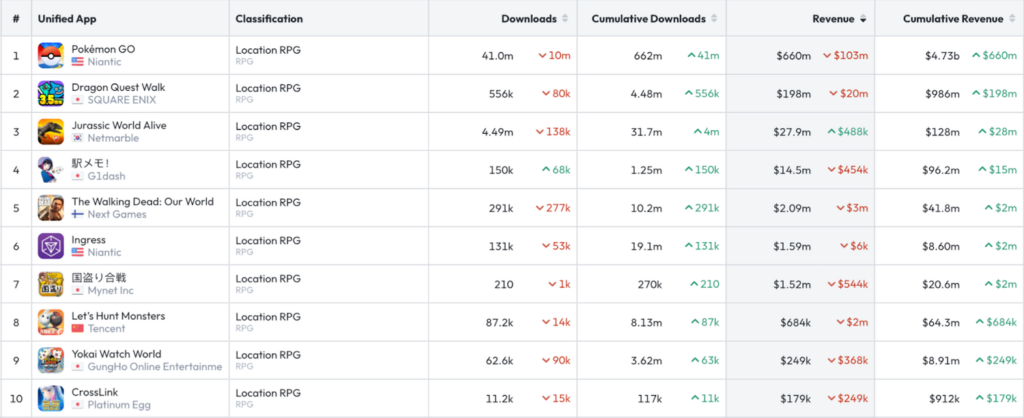
Another crucial factor in this genre is the role of intellectual property (IP). The top three titles are based on highly successful international IPs: Pokémon, Dragon Quest, and Jurassic World. Additionally, two other games on the market draw from well-known Western franchises: The Walking Dead and The Witcher, which we will discuss shortly.
A recognizable IP often serves as a strong unique selling point across various genres, but mobile location-based games appear to be particularly sensitive to this element. Many players download these games to engage with their favorite universes and envision how the creatures from these worlds would appear in AR.
However, a strong IP does not always guarantee success. In 2019, Niantic released another promising AR title, Harry Potter: Wizards Unite, but the game failed to attract a broad audience and fell short of the developer’s expectations. Consequently, Niantic announced the game's closure at the end of January 2022. As for The Witcher game, CD Projekt Red plans to shut it down by the end of June 2023.
The VR Growth and Investment Landscape
Examining the sector beyond mobile, the VR/AR gaming segment is projected to experience significant growth over the next two years, with an estimated value of $3.2 billion by 2024, according to NewZoo. This forecast is bolstered by the robust performance of VR games in recent years. Following the onset of the COVID-19 pandemic, the segment's revenue has nearly doubled, rising from just under $1 billion in 2020 to close to $1.9 billion in 2022.
The observed growth was supported by robust investment and merger and acquisition activity. However, the funds allocated to the VR/AR gaming segment have experienced a significant decline since 2020. Notably, the second quarter of 2020 and the fourth quarter of 2022 stand out in terms of total deal size, primarily due to two investments in Magic Leap — first from a group of new and existing investors, and then again in January of this year from the Saudi Public Investment Fund.
Prior to the 2020-2023 timeframe, a major investment in the VR gaming market occurred when Facebook acquired Oculus VR for $2 billion in 2014. This acquisition allowed Facebook to establish itself as a key player in the VR gaming industry and set the stage for further investments and deals in the sector. The sector has yet to see a deal of this size since, underscoring the VR sector’s challenges in appealing to mainstream consumers since the launch of the original Oculus Rift in 2016.
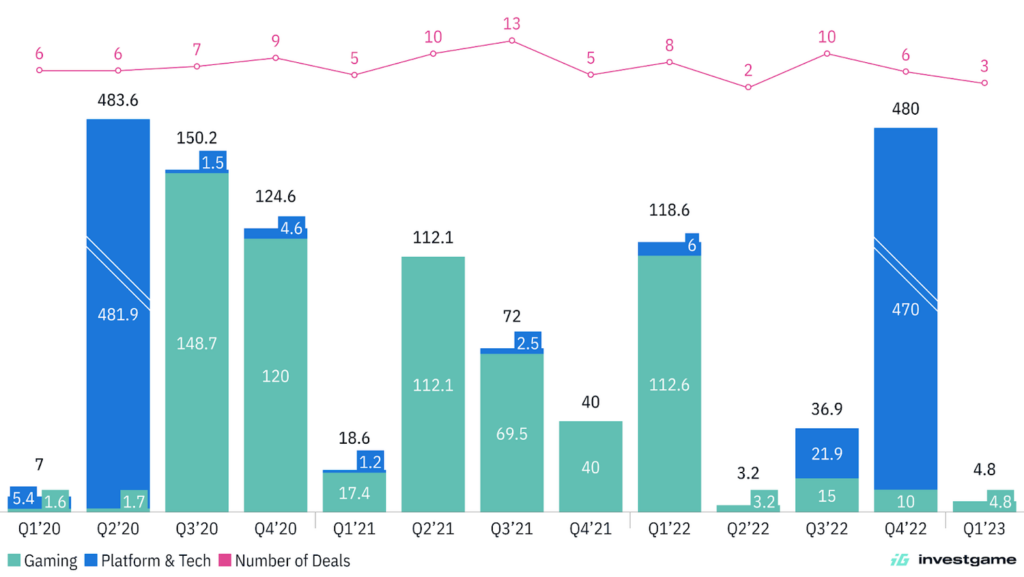
(Still) A Long Road from Niche to Mainstream
It's crucial to recognize that VR remains a niche category and has much progress to make before becoming truly mainstream. VR headsets are still costly, the game offerings limited, and the technology hampered by numerous constraints.
Although these challenges can be addressed through ongoing investment and innovation, it's essential to understand that the success of VR/AR ultimately relies on capturing consumer interest. In the mobile realm, we observe that location-based and AR games have struggled to find an audience without robust IP, and the segment needs to explore new ways to attract and, more importantly, retain players. For VR, it’s clear that beyond a small number of standout software titles that have earned the title of system sellers, like Valve’s Half-Life: Alyx, there has yet to be what you might consider a killer app.
In spite of these hurdles, we maintain a cautious optimism about the long-term prospects of VR gaming. We anticipate investment activity to rebound once the investment climate improves. However, the true surge in the sector will likely occur when VR headsets become a standard feature in the homes of average gamers. (Written by InvestGame)
#2: To Hell & Back: Diablo Immortal Live-Ops Retrospective
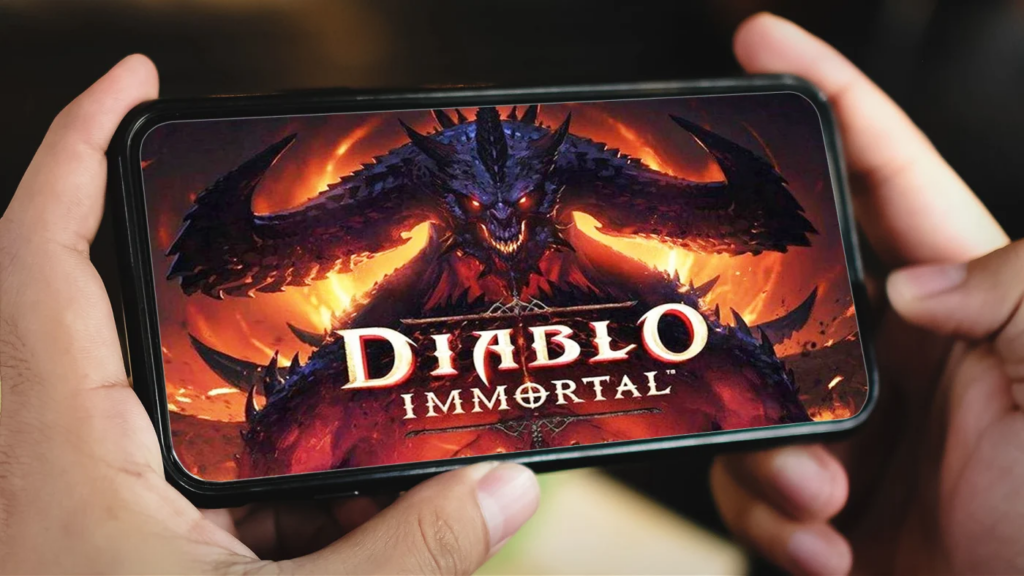
This piece is a preview of a research essay written by Becky Matthew for Naavik Pro. To read the full piece, along with our other Naavik Pro content, request a trial now.
One of Blizzard’s most popular franchises, Diablo, had its mobile debut in June of last year with the release of Diablo Immortal, an on-the-go, free-to-play homage to the hack-and-slash PC franchise. Despite being the largest launch in the franchise's history, the game received a less-than-desirable response at release.
In terms of pure press attention, Diablo Immortal was the most prominent mobile game launch of 2022 — but not in the way Blizzard may have hoped. Although review aggregation sites are hardly the judge of a game’s quality or an accurate predictor of potential, some indicators cannot be ignored. For example, Diablo Immortal currently holds among the lowest-ever recorded user scores on the review aggregation website Metacritic.
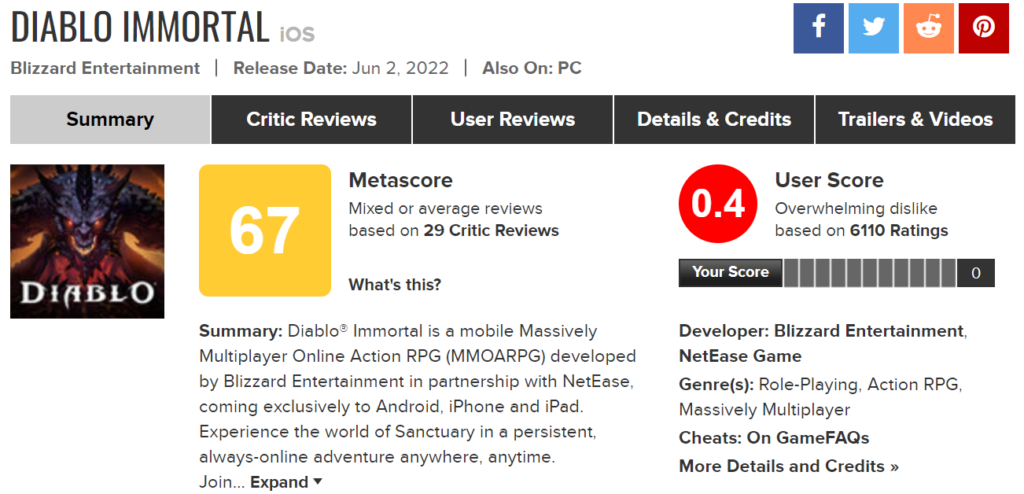
In addition to the change in business model and platform, this audience backlash is likely a question of dwindling company and brand trust. The game launched against the backdrop of reports of rampant sexual harassment and discriminatory practices at the studio and publisher Activision Blizzard as a whole, an ongoing saga that had led to a number of lawsuits against the company.
That’s not to mention news stories of Diablo Immortal allegedly requiring excessive real-money spending to make meaningful progress. The result was that fans entered Diablo Immortal with a sour perspective — players who may have otherwise approached the mobile version with a more open-minded perspective.
Despite all this, Diablo Immortal has maintained an impressive position in top chart positions worldwide at No. 4 most downloaded and No. 9 top-grossing game on iOS for the past several months, according to data.ai.
The game has several things going for it to help justify its popularity. For one, Diablo Immortal is mobile-first yet with a PC port, similar to Raid: Shadow Legends. It’s also the first in the series with a F2P business model. The game is available globally on Android and iOS, as well as on PC via Battle.net.
The official gameplay trailer for Diablo Immortals should feel familiar to fans of the series. | Source: YouTube.
Immortal features everything a player could want from a Diablo game: fountains of loot that appear in plenty, showstopping set pieces with memorable bosses, and large waves of enemies that make you feel powerful as you destroy wave upon wave in succession. Diablo is known for tight combat and a high level of polish, and Immortal delivers on that with real-time, visceral combat at its finest.
The gameplay loop is simple. Players explore, kill enemies, and raid dungeons to gain experience and loot to increase their power. These few steps are the formula to what makes a Diablo game a Diablo game.

Aside from the core gameplay, Diablo is, at its core, an MMO. Each zone hosts players that are free to chat, interact, and join forces with one another to tackle numerous quests and events in multiplayer groups.
Despite the hostile reception regarding monetization design choices, players have praised the game for its high production value and mobile-first approach. Like Hearthstone, Blizzard’s take on the Collectible Card Game, Immortal is also available on PC, making the game an attractive offering to players who perhaps prefer cross-platform gaming and don’t want to be restricted to a smartphone screen.
With the addition of cross-play, players are incentivized to diversify their primary platform and continue their progress on the go without sacrificing experience or progress. From a business perspective, this is highly beneficial for rising player LTV. Blizzard fans are largely loyal, so presenting a way to gain access to more of their favorite titles, or approach them differently, only strengthens the player’s bond with the product.
Content Worth Consuming
Second Dinner’s Ben Brode reveals Marvel Snap’s recipe for success (Mobilegamer.biz): “I think most people misunderstand the relationship between luck and skill,” said Brode. “A lot of people imagine it as a scale where you’ve got luck on one side, and skill on the other…but that’s not how it works at all… games in the ‘high luck, high skill’ category I think are super fun, because they include a ton of interesting decisions, but they also have exciting moments that are different every time you play them.” Link
‘True Ownership’ — The Game Economy Trilemma (Deconstructor of Fun): “Contrary to what most web 3 and crypto gaming proponents would have you believe, the idea of ‘true ownership’ of your in-game assets is neither new nor unique to Web3. Companies like Blizzard and Valve have been trying to make it happen for years and to some extent have already succeeded with products like the Wow Tokens or the Steam Workshop. The definition and feasibility of ‘true ownership’ as a concept in web3 is vastly misunderstood and played fast and loose with for fun and profit.” Link
Exploring the complexities of humanity through video games (Gamesindustry.biz): “Roman Alkan began making video games at 18. The realisation that she could make money from these projects shifted her games development from hobby to career. Today, she stands at the head of indie games studio Larky Labs, and has been named as one of this year's Ensemble cohort – an exhibition dedicated to showcasing Black, Asian and underrepresented ethnicities working in the UK games industry. Alkan spoke to GamesIndustry.biz during this year's Ensemble photoshoot to share more of her story, and her desire to see more complex characters explored through video games.” Link
The Journey of Netxt Games to Becoming a Netflix Studio (Rise and Play): Saara Bergström is the COO at Next Games, a Finnish mobile game developer recently acquired by Netflix, known for their successful IP mobile titles such as Stranger Things: Puzzle Tales and The Walking Dead: No Man’s Land. Saara has had a close to a 15-year career in advertising, product marketing and public relations. At Next Games, where she has worked for nearly 10 years, she pivoted from CMO to COO last year and started a new journey officially in an operations role. In this episode, we will walk you through Next Games’ cultural journey and transformation from its early startup days, to the company’s financial restructuring, to going IPO, to becoming a Netflix studio. Link
🔥Featured Jobs
- Coda Payments: VP of Growth (Los Angeles, California)
- Lila Games: Systems and Economy Game Designer (Bangalore, India)
- FunPlus: Lead Game Designer - New Casual Studio (Barcelona, Spain)
You can view our entire job board — all of the open roles, as well as the ability to post new roles — below. We've made the job board free for a limited period, so as to help the industry during this period of layoffs. Every job post garners ~50K impressions over the 45-day time period.




